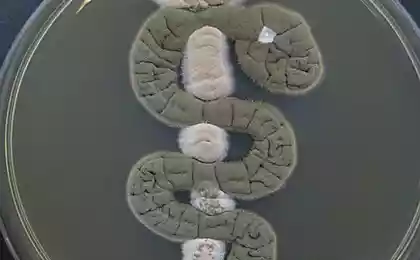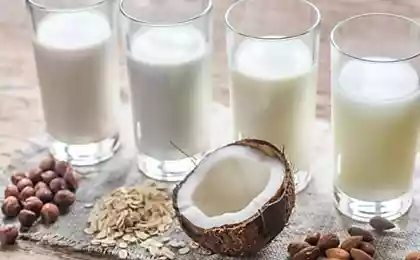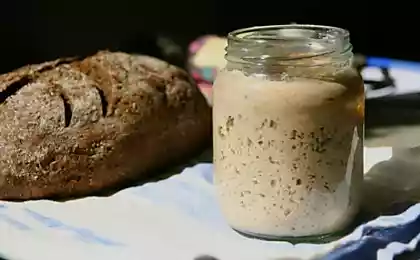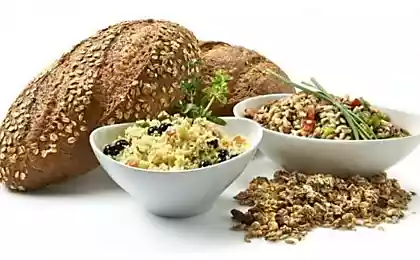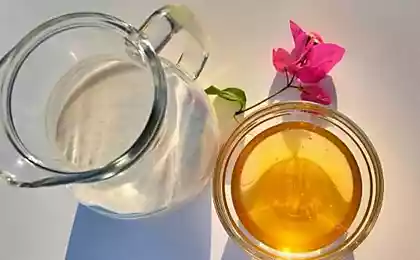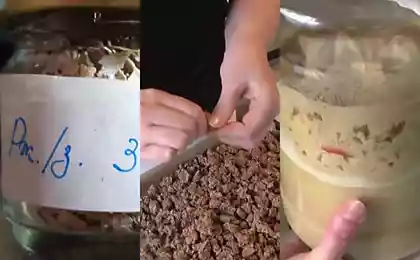561
The kurung — this drink puts on his feet even seriously ill
The kurung - a fermented milk product prepared on the natural multicomponent leaven from cow's milk, widespread until recently among the peoples of Central and Northern Asia. Taste in respect of kurung — sour, effervescent product similar to Mare.
The content of protein, fat and minerals as well as vitamins A and b kurung is superior to the Mare, giving him only by the content of milk sugar, alcohol and vitamin C.
A big advantage of korangi compared to Mare's milk is its cheapness, availability and ease of preparation. It can be considered as the koumiss made from cow's milk. But at the same time as the preparation of kumys require conditions and time, kurung in the presence of starter cultures can be prepared everywhere and at any time of the year.

Technology homemade EM-Kurunga and its derivatives
1. Preparation of primary ferment.
One dose (2 grams) dry EM-Kurunga pour into small bottle or flask ( 100-200 ml), pour the brim of pasteurized or sterilized milk ( fat content of 0.5 — 2.5%), close tightly with a lid and mix well by shaking the bottle. To withstand day at room temperature. Frequent shaking facilitates uniform distribution of the microorganisms in the sourdough.
2. Cooking healthful drink.
A day yeast pour into a quart jar, add milk to the top. After the separation of the beverage into a dense clot and serum (a day or two) drink can be consumed, leaving each time half of EM-Kurunga and adding to the top of milk. This procedure can be repeated within 2-4 weeks, then it is better to prepare a new starter.
A properly cooked kurung is a frothy drink sour wine flavor with a distinctive aroma. Before use, exfoliate the kurung mix well. To reduce acidity you can add a little milk. But persons with I and II blood group, usually can not tolerate milk, so it's best to use zakislenna kurung in which lactose and milk protein has been processed by microorganisms. For deoxidation in this case it is better to add water and honey.
For those who are not very fond of sour drinks, cook krugovoy Mead. This is the easiest method of growing microbial complex in milk. Three liters of warm boiled water add 3 tablespoons of honey and half a Cup krugovoy serum obtained by filtering karungi through a thick cloth. Through each day of fermentation at room temperature to add 1 tablespoon of honey. For 3-4 days the Mead is ready to drink. Take a glass 20 minutes before eating.
Regimen Karungi

Useful tips:
* With the use of kurumi for the first time, to avoid indigestion in the first 1-2 days to limit one-time reception within ¼ or ½ Cup.
* In order to avoid unpleasant smell of the dishes from under karungi should be changed weekly. The odor is not from kurumi, and from the edges of the jars and lids, where without access to fresh milk (food) is autolysis.
* For targeted treatment can be prepared carungay extract of various herbs. For example, severe dysbiosis, related to tuberculosis, is usually administered a decoction of the following herbs:
The same collection with great success can be used for the extraction of its medicinal substances carungay. For this to 1 liter of fresh karungi used 1 tablespoon of the collection and infused gauze or nylon bag directly in a drink.
Carungay extract is used in common for kurumi scheme. Every week a bag with the collection of herbs changed to fresh.
Thus, you can use any herb or fees, asking kurunga specific healing properties possessed by these herbs.
AgeNumber of doses, the Daily dose for Children from 1 year to 4-5 years
5 times
per day 100 — 200 ml
Children older than 5 years and adults
1 time in the morning or evening
1 Cup
Microbiology karungi and its probiotic properties
The kurung is a liquid foaming product is milky white with small flakes of casein, with a sour odor and taste, obtained by fermentation of cow's milk with lactic acid bacteria and dairy yeast.
Some rightly call the kurung a living beverage, as it continues the vital activity of microorganisms, which cause the transformation of milk sugar into lactic acid, alcohol and carbon dioxide. Therefore, education kurumi is a purely microbial process, the success of which mainly depends on the properties of microorganisms and their living conditions (temperature, aeration, etc.); in other words, the quality of kurunga depends on starter cultures and production technology.
In kurume we have not a mechanical mixture of the various elements of the microflora, as a typical phenomenon of symbiosis. Yeast for its development need to be waste products of lactic acid bacteria and formed their lactic acid. Lactic acid bacteria in the presence of yeast develop better and longer retain their activity. These symbiotic relationships in kurunga persist for a long time without suppression of one of the constituent elements of other microflora.
Even in a wooden tub in a village, not a sterile environment, for many years made of kurung the skillful conduct of the fermentation is unchanged. The production of "cultivated" Mare's milk, and especially kefir requires to prevent in the process of fermentation of extraneous microflora. For kurumi natural "outside" microflora is required. It determines the healing properties of the main fractions of the microbial Association, their antibiotic activity.
Antibiotics, as specific products of microorganisms that possess high physiological activity against certain pathogenic bacteria, viruses or malignant processes, delaying their growth or completely inhibiting their development. But antibiotics antibiotics different.
It is time you make changes in the conceptual framework. The word "antibiotic" means "against life." In this sense, all of the antibiotics, derived from pure cultures, justifies its name. Even if they are derived from some harmless lactic acid Bacillus or bifidobacteria. Microbes-symbionts, grown separately, produce harmful antibiotics. These microbial symbionts grown in symbiosis produce useful antibiotics. It cannot be otherwise. Single (selfish) destroy all around him, the collectivists build around.
Therefore, the antibiotic activity of the symbiosis should have been called symbiotic, and their biologically active substances — symbiotically, that is, substances that do not accept the symbiosis of alien pathogens. For clarity we can say: "Antibiotics kill everyone, SymbioticA only strangers".
A study of the microflora of kurunga engaged many researchers, but no one was able to figure out what nature is powerful in its physiological effects of the drink.
A comparative analysis of literature data shows that the kurung contains the entire flora, which is found in Mare's milk, kefir, yogurt, Subate, Chala, etc. and a whole group of microorganisms, the so-called "outsiders", but very important.
The accumulated yeast alcohol inhibits the rate of cell division, slowing down the aging of the population. Acidification of the environment caused by the lactic acid bacteria, giving yeast a competitive advantage, especially in the substrates, provided enough carbohydrates and nitrogen containing substances.
Lactobacilli kurumi can be attributed to two types.
Lactobacillus acidophilus in co-culture with acetic acid bacteria contribute to the accumulation of antibiotic substances acidophilus and lactocidin.
Acetic acid bacteria are in symbiosis with lactic acid. They are used as an energy source lactic acid, respectively, reducing the acidity of the environment and creating favorable conditions for lactic acid bacteria.
During prolonged storage karungi acetic acid bacteria preserve its activity, enhance antibiotic activity. The consistency of kurumi becomes thick and viscous, owing to the partial decomposition of proteins, enrichment of the medium with vitamin B12. Accordingly, it changes the taste of the drink.
Streptococci and streptobacilli kurumi are active kislotoobrazoutei.
Note that the kurung is characterized by a kind of constancy of the qualitative composition of microorganisms, but is not very resistant to quantitative relation them according to the samples karungi.
The explanation of the variability in the content of major groups of microorganisms and products of lactic and alcoholic fermentations in kurunga cooked on natural leaven, can be milk quality, microbiological composition and dose of yeast, mode of preparation, which in the home fluctuate.
Because the quality of kurunga depends on the quantitative ratio of lactic acid and alcohol, both types of fermentation should proceed in concert. With increasing fermentation temperature to 25-28 degrees turns sharply sour kurung, almost effervescent due to increased lactic fermentation. On the contrary, extreme lowering of temperature, slowing of lactic acid fermentation increases the alcoholic fermentation, and kurung is unpleasant, yeast, acid-free taste. The optimum temperature for fermentation krugovogo is 20-22 degrees.
Protein substances in kurunga undergo the same changes in the Mare. Their decomposition occurs under the influence of proteolytic enzymes secreted by bacteria and gidroliticheskogo actions resulting in kurunga lactic acid.
Fat milk at karungulam fermentation varies slightly. But usually for cooking karungi prefer to take low-fat milk (2-2,5%) as the kurung of fat milk is worse tolerated in diseases of the gastrointestinal tract.
Talking about the average chemical composition of kurangi, we should not forget about the composition of the raw material, i.e. milk, which is made of kurung.
Cornholegame as a method of rehabilitation bacteriotherapy
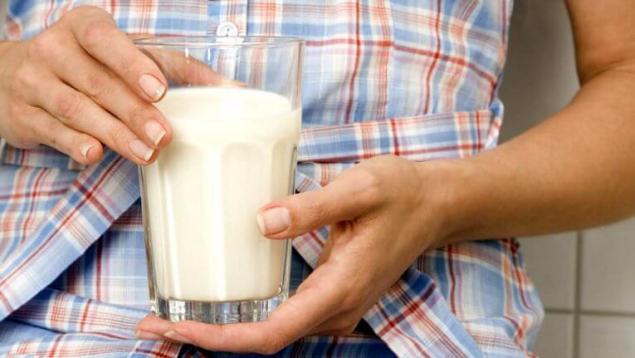
Usually goiter is perceived as an ephemeral concept, this ignores the fact that any infection, its manifestation is is dysbacteriosis (dysbiosis).
Giving timely recovery of microbiocenosis of the intestinal tract? At least, the restoration of General immunity.
It is a lot or a little? Enough to have an enviable health.
What probiotics are preferable for correction of the intestinal microflora? Definitely is a natural symbiotic complexes.
One of the important results of corangamite is a persistent increase in the weight on average of 4 kg in malnourished patients. As a result of treatment in most patients was significantly increased hemoglobin on average by 53.5% due to the increase usefulness of red blood cells. In 70% of cases, ROE decreased to normal! By the end of cornholegame to normal came and leukocytic picture.
There is no doubt that krugolina will have a positive effect with immunodeficiency, cancer.
Such Wellness results in recovery of microbiocenosis, it might be considered surprising, if not proof, that this is normal and inherent in humans and animals evolutionary.
Studies have shown that the antibiotic activity of the product is closely linked with the diversity and content of "foreign" bacteria — usually with reduction of their diversity and content, and decreases the antibiotic activity of the product.
Also interesting: the Cleansing of the body buckwheat with yogurt
The secrets of proper cleansing of the body
P. S. And remember, only by changing their consumption — together we change the world! ©
Source: emcooperation.ru/kurungolechenie
The content of protein, fat and minerals as well as vitamins A and b kurung is superior to the Mare, giving him only by the content of milk sugar, alcohol and vitamin C.
A big advantage of korangi compared to Mare's milk is its cheapness, availability and ease of preparation. It can be considered as the koumiss made from cow's milk. But at the same time as the preparation of kumys require conditions and time, kurung in the presence of starter cultures can be prepared everywhere and at any time of the year.

Technology homemade EM-Kurunga and its derivatives
1. Preparation of primary ferment.
One dose (2 grams) dry EM-Kurunga pour into small bottle or flask ( 100-200 ml), pour the brim of pasteurized or sterilized milk ( fat content of 0.5 — 2.5%), close tightly with a lid and mix well by shaking the bottle. To withstand day at room temperature. Frequent shaking facilitates uniform distribution of the microorganisms in the sourdough.
2. Cooking healthful drink.
A day yeast pour into a quart jar, add milk to the top. After the separation of the beverage into a dense clot and serum (a day or two) drink can be consumed, leaving each time half of EM-Kurunga and adding to the top of milk. This procedure can be repeated within 2-4 weeks, then it is better to prepare a new starter.
A properly cooked kurung is a frothy drink sour wine flavor with a distinctive aroma. Before use, exfoliate the kurung mix well. To reduce acidity you can add a little milk. But persons with I and II blood group, usually can not tolerate milk, so it's best to use zakislenna kurung in which lactose and milk protein has been processed by microorganisms. For deoxidation in this case it is better to add water and honey.
For those who are not very fond of sour drinks, cook krugovoy Mead. This is the easiest method of growing microbial complex in milk. Three liters of warm boiled water add 3 tablespoons of honey and half a Cup krugovoy serum obtained by filtering karungi through a thick cloth. Through each day of fermentation at room temperature to add 1 tablespoon of honey. For 3-4 days the Mead is ready to drink. Take a glass 20 minutes before eating.
Regimen Karungi

Useful tips:
* With the use of kurumi for the first time, to avoid indigestion in the first 1-2 days to limit one-time reception within ¼ or ½ Cup.
* In order to avoid unpleasant smell of the dishes from under karungi should be changed weekly. The odor is not from kurumi, and from the edges of the jars and lids, where without access to fresh milk (food) is autolysis.
* For targeted treatment can be prepared carungay extract of various herbs. For example, severe dysbiosis, related to tuberculosis, is usually administered a decoction of the following herbs:
- Chamomile flowers - 2 parts
- Sage leaves - 1 part
- Mother-and-stepmother, leaves - 2 parts
- Calendula flowers — 5 pieces
- Birch buds, kidneys — 2 parts
- Cowberry leaf, leaves — 2 parts
The same collection with great success can be used for the extraction of its medicinal substances carungay. For this to 1 liter of fresh karungi used 1 tablespoon of the collection and infused gauze or nylon bag directly in a drink.
Carungay extract is used in common for kurumi scheme. Every week a bag with the collection of herbs changed to fresh.
Thus, you can use any herb or fees, asking kurunga specific healing properties possessed by these herbs.
AgeNumber of doses, the Daily dose for Children from 1 year to 4-5 years
5 times
per day 100 — 200 ml
Children older than 5 years and adults
1 time in the morning or evening
1 Cup
Microbiology karungi and its probiotic properties
The kurung is a liquid foaming product is milky white with small flakes of casein, with a sour odor and taste, obtained by fermentation of cow's milk with lactic acid bacteria and dairy yeast.
Some rightly call the kurung a living beverage, as it continues the vital activity of microorganisms, which cause the transformation of milk sugar into lactic acid, alcohol and carbon dioxide. Therefore, education kurumi is a purely microbial process, the success of which mainly depends on the properties of microorganisms and their living conditions (temperature, aeration, etc.); in other words, the quality of kurunga depends on starter cultures and production technology.
In kurume we have not a mechanical mixture of the various elements of the microflora, as a typical phenomenon of symbiosis. Yeast for its development need to be waste products of lactic acid bacteria and formed their lactic acid. Lactic acid bacteria in the presence of yeast develop better and longer retain their activity. These symbiotic relationships in kurunga persist for a long time without suppression of one of the constituent elements of other microflora.
Even in a wooden tub in a village, not a sterile environment, for many years made of kurung the skillful conduct of the fermentation is unchanged. The production of "cultivated" Mare's milk, and especially kefir requires to prevent in the process of fermentation of extraneous microflora. For kurumi natural "outside" microflora is required. It determines the healing properties of the main fractions of the microbial Association, their antibiotic activity.
Antibiotics, as specific products of microorganisms that possess high physiological activity against certain pathogenic bacteria, viruses or malignant processes, delaying their growth or completely inhibiting their development. But antibiotics antibiotics different.
It is time you make changes in the conceptual framework. The word "antibiotic" means "against life." In this sense, all of the antibiotics, derived from pure cultures, justifies its name. Even if they are derived from some harmless lactic acid Bacillus or bifidobacteria. Microbes-symbionts, grown separately, produce harmful antibiotics. These microbial symbionts grown in symbiosis produce useful antibiotics. It cannot be otherwise. Single (selfish) destroy all around him, the collectivists build around.
Therefore, the antibiotic activity of the symbiosis should have been called symbiotic, and their biologically active substances — symbiotically, that is, substances that do not accept the symbiosis of alien pathogens. For clarity we can say: "Antibiotics kill everyone, SymbioticA only strangers".
A study of the microflora of kurunga engaged many researchers, but no one was able to figure out what nature is powerful in its physiological effects of the drink.
A comparative analysis of literature data shows that the kurung contains the entire flora, which is found in Mare's milk, kefir, yogurt, Subate, Chala, etc. and a whole group of microorganisms, the so-called "outsiders", but very important.
The accumulated yeast alcohol inhibits the rate of cell division, slowing down the aging of the population. Acidification of the environment caused by the lactic acid bacteria, giving yeast a competitive advantage, especially in the substrates, provided enough carbohydrates and nitrogen containing substances.
Lactobacilli kurumi can be attributed to two types.
- The first type of properties close to the Bulgarian Bacillus.
- The second type produces more acid, sbragia all carbs, approaching in its properties to the Bacillus acidophilus.
Lactobacillus acidophilus in co-culture with acetic acid bacteria contribute to the accumulation of antibiotic substances acidophilus and lactocidin.
Acetic acid bacteria are in symbiosis with lactic acid. They are used as an energy source lactic acid, respectively, reducing the acidity of the environment and creating favorable conditions for lactic acid bacteria.
During prolonged storage karungi acetic acid bacteria preserve its activity, enhance antibiotic activity. The consistency of kurumi becomes thick and viscous, owing to the partial decomposition of proteins, enrichment of the medium with vitamin B12. Accordingly, it changes the taste of the drink.
Streptococci and streptobacilli kurumi are active kislotoobrazoutei.
Note that the kurung is characterized by a kind of constancy of the qualitative composition of microorganisms, but is not very resistant to quantitative relation them according to the samples karungi.
The explanation of the variability in the content of major groups of microorganisms and products of lactic and alcoholic fermentations in kurunga cooked on natural leaven, can be milk quality, microbiological composition and dose of yeast, mode of preparation, which in the home fluctuate.
Because the quality of kurunga depends on the quantitative ratio of lactic acid and alcohol, both types of fermentation should proceed in concert. With increasing fermentation temperature to 25-28 degrees turns sharply sour kurung, almost effervescent due to increased lactic fermentation. On the contrary, extreme lowering of temperature, slowing of lactic acid fermentation increases the alcoholic fermentation, and kurung is unpleasant, yeast, acid-free taste. The optimum temperature for fermentation krugovogo is 20-22 degrees.
Protein substances in kurunga undergo the same changes in the Mare. Their decomposition occurs under the influence of proteolytic enzymes secreted by bacteria and gidroliticheskogo actions resulting in kurunga lactic acid.
Fat milk at karungulam fermentation varies slightly. But usually for cooking karungi prefer to take low-fat milk (2-2,5%) as the kurung of fat milk is worse tolerated in diseases of the gastrointestinal tract.
Talking about the average chemical composition of kurangi, we should not forget about the composition of the raw material, i.e. milk, which is made of kurung.
Cornholegame as a method of rehabilitation bacteriotherapy

Usually goiter is perceived as an ephemeral concept, this ignores the fact that any infection, its manifestation is is dysbacteriosis (dysbiosis).
Giving timely recovery of microbiocenosis of the intestinal tract? At least, the restoration of General immunity.
It is a lot or a little? Enough to have an enviable health.
What probiotics are preferable for correction of the intestinal microflora? Definitely is a natural symbiotic complexes.
One of the important results of corangamite is a persistent increase in the weight on average of 4 kg in malnourished patients. As a result of treatment in most patients was significantly increased hemoglobin on average by 53.5% due to the increase usefulness of red blood cells. In 70% of cases, ROE decreased to normal! By the end of cornholegame to normal came and leukocytic picture.
There is no doubt that krugolina will have a positive effect with immunodeficiency, cancer.
Such Wellness results in recovery of microbiocenosis, it might be considered surprising, if not proof, that this is normal and inherent in humans and animals evolutionary.
Studies have shown that the antibiotic activity of the product is closely linked with the diversity and content of "foreign" bacteria — usually with reduction of their diversity and content, and decreases the antibiotic activity of the product.
Also interesting: the Cleansing of the body buckwheat with yogurt
The secrets of proper cleansing of the body
P. S. And remember, only by changing their consumption — together we change the world! ©
Source: emcooperation.ru/kurungolechenie

